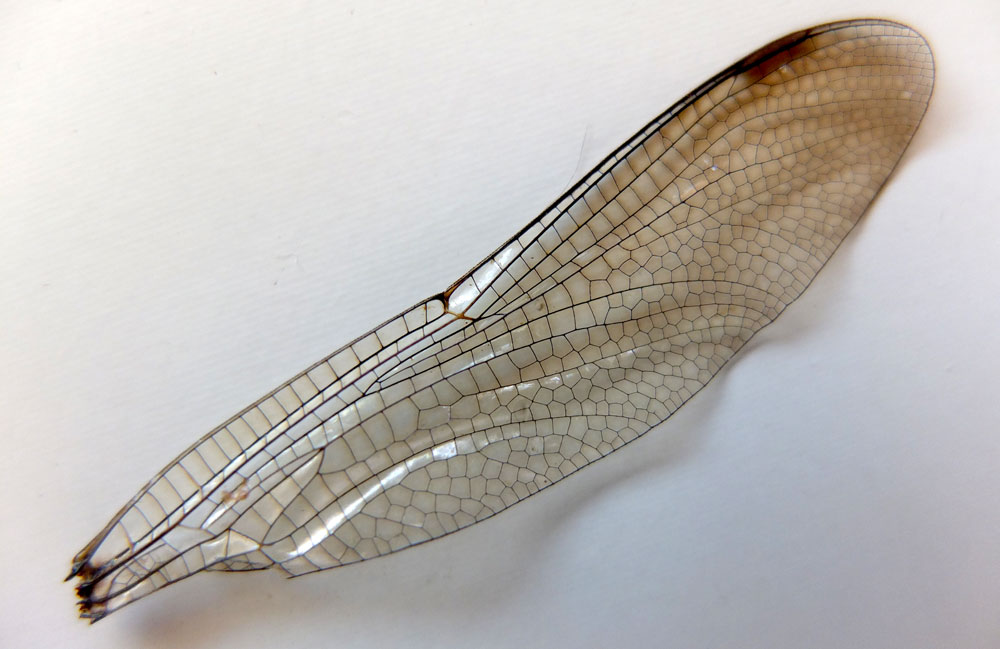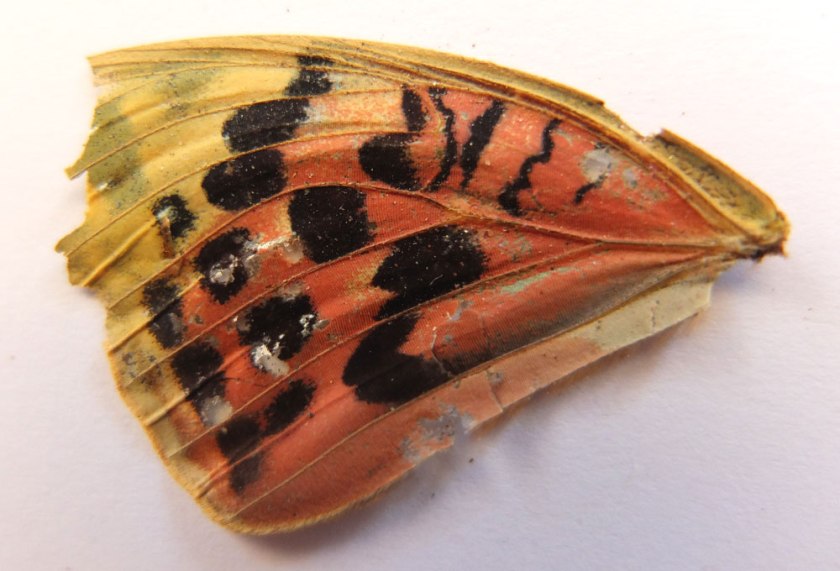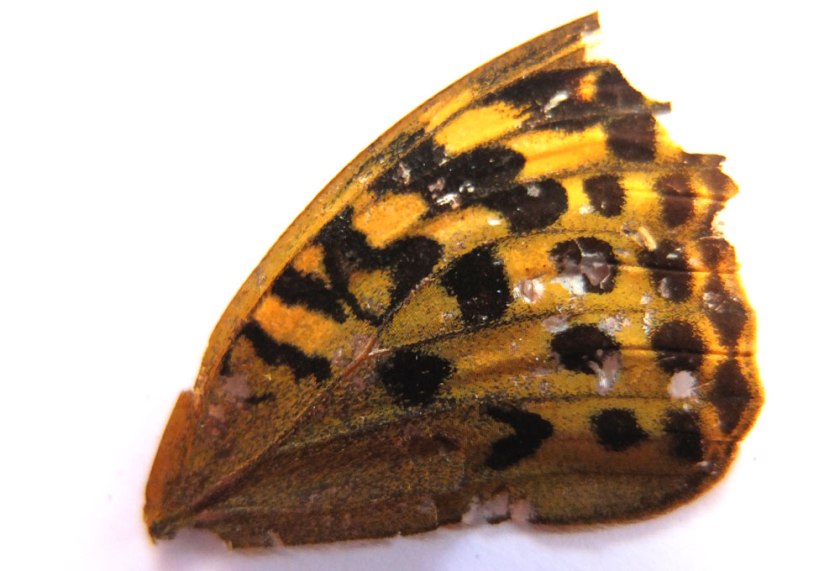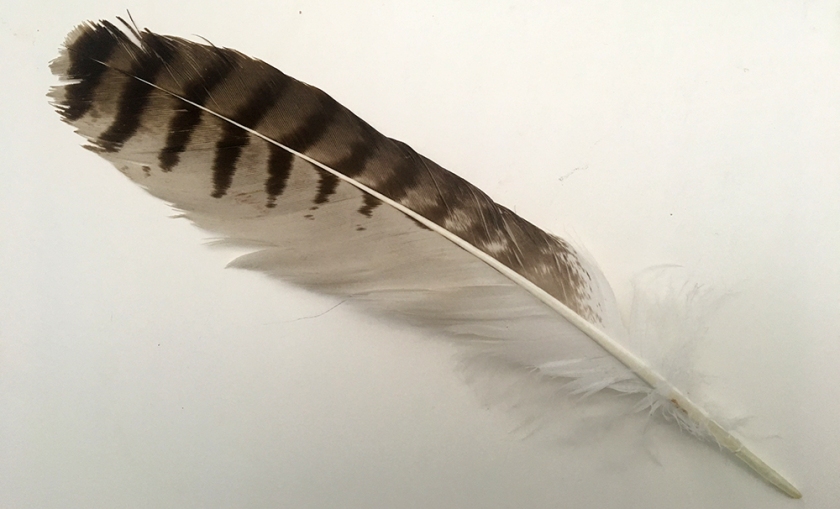I guess I will always think there is something magical and mysterious about flight. Not flying in an aeroplane or helicopter, but real winged flight like that of bugs, butterflies, birds and mythological creatures.
As a child I was sure I could fly, but knew this was an ability you lost as you got older. I don’t know if I thought the skill was lost at a certain age, or weight, or quite what, though remember Catherine Jones, a classmate just a few months younger than me, claiming she still retained the power when I was already grounded.
Perhaps that memory of flight, still experienced occasionally in dreams, explains the collection of insect wings and feathers I have amassed over the years. Maybe there’s an atavistic belief that if I gather enough of them I will be able to stitch my own wings and regain my lost youth.
In the park the other day I found this feather.
I don’t remember having seen one quite like it and wondered what bird it came from. Not a magpie, clearly, nor a pigeon or dove, and probably not a woodpecker. There are jays in the park, but although they have some beige feathers, I’m not sure those are the main flight feathers and I don’t think they would be barred like this.
Still, now I’ve mentioned jays, I may as well post a brief poem of other blue birds, which brought me great joy when they flocked in the trees around our house when I lived rural Spain.
Blue birds
The sleek black elegance of executioners’ hoods
and muted shades of beige and dusky blue belie
the rabilargos‘ raucous voice and acrobatic repertoire.
With strident glee they trampoline from twig to twig,
unfurl their summer-evening wings like fans, revealing
azure blue as vivid as the cloudless Spanish sky.
As always, when I need to identify plants or wildlife, I turned to Google to help me. So after much looking at feathers of all sorts of species, I have decided we must have tawny owls in the park. It’s not surprising that I haven’t noticed, as I tend not to go there after dark.
But when I lived in Spain, we lived in the middle of nowhere; the Milky Way arched high above our house and I was far more at home in the night. Thinking about it has made me nostalgic, so here is a slightly tweaked piece I wrote many years ago, which seems to fit the theme of today’s musings.
Wings in the night
One Saturday night in spring, when my partner was away on business, I was surfing the web; I assumed that the cat was around somewhere, probably keeping the office chair warm in my partner’s absence; as long as Tucker wasn’t bothering me, I wasn’t going to bother about him.
Then he started: “Miaow. Miaaoooww.”
Although we had no near neighbours I’d never been worried about prowlers: the house was almost invisible from the road and you had to know where the driveway was to get to it, so I tended to leave doors and windows unlocked. On this occasion, it was a mild evening, so the front door was wide open, but the screen door was latched as Tucker was brought up a house cat and even after moving to the country he was happiest indoors.
I guessed he must have seen something outside that interested him. I made some comforting clucking noises as I couldn’t believe it was more than a hedgehog. Then the ensuing conversation went like this:
“Miaow.”
“Mmm?”
“Miaow.”
“Yeah?”
“Miaaow.”
“What?”
“Miaaoow.”
“What’s up, pussycat?”
“Miaaaooww.”
“It’s ok, Tucker.”
“Miaaoow.”
“There’s no-one there.” True, I hadn’t actually checked, but, as I said, the house was set away from the neighbours and I was pretty sure there wasn’t anyone about.
“Mraaoow.”
“Ok, I’ll come and look.” It had become clear that my platitudes were not enough to comfort him, so direct action was needed.
Still clucking reassuringly, I got up to check what the matter was. And found that there was indeed a visitor: attracted by the lights in the studio, the biggest moth I had ever seen was trying to come in. As it flustered against the screen door, I had a perfect view of the huge eyes on its rusty-brown and cream wings.
I went off in search of a camera, but it had gone by the time I got back. I was quite relieved, and so was Tucker: like I said, he was a house cat and nature wasn’t really his thing. I shut the door to keep the world out there in its place and took him back to the computer with me.
A bit later, when he had settled, I looked outside again and found the moth hadn’t gone very far: it was holed up in the empty log bucket I’d left outside the door. This time I knew where the camera was, and managed to get some photos; I was surprised it wasn’t bothered by the flash, but it just stayed there minding its own business.
I searched on Google and found that the visitor was in fact a Giant Peacock Moth, whose eight-inch wingspan makes it the largest native European moth. Close observation of the photos I had downloaded revealed that it was a female – the males have feathery antennae whereas our visitor’s antennae were fine and stringy. The females are fatter than the males, too, because of the eggs they carry, but also, presumably, so that they can live off their energy stocks as they don’t eat at all in the adult state; it didn’t sound like much of a life to me.
The next morning the Giant Peahen was still at the bottom of the log bucket, busy producing a clutch of small white eggs arranged in perfect geometrical symmetry. This moth was a mother. I’d even go so far as to say she was the mothest.
It seemed heartless to turn her away when she was fulfilling her raison d’être, but Google had told me that peachick caterpillars like to feast on cherry and pear leaves, which boded ill for the well-tended trees just coming into leaf in the orchard. I don’t like to kill any creatures, and certainly not one as big and beautiful as this, so I took the bucket up to the top of the garden by the gate as far as possible from the fruit trees.
When in doubt, procrastinate.
Around lunchtime I was feeling guilty so went to see how she was getting on. But she was no longer there.
Nor was the bucket, which the Romanian gardener had obviously found when he arrived that morning and had returned to its place in the shed. I know he considered me strange with my environmentally-friendly ideas about chemical sprays, so I didn’t pluck up courage to ask if he’d seen the moth as I wasn’t sure I wanted to know what had happened to her.
It occurred to me, though, that I’d never asked where in Romania he was from. I’ve heard there are some terrifying night-flying monsters in the Carpathian mountains.





Namaste,
What would it mean to you to know that feathers have a complex symbolism attached to them? Likewise, so do Owls and Moths.
Whilst one’s sublunary mind seeks to ground us, our imagination yearns to fly.
“Once you have tasted flight, you will forever walk the earth with your eyes turned skyward, for there you have been, and there you will always long to return.” ~ Leonardo da Vinci ~
Namaste
DN
LikeLiked by 1 person
The lore of the natural world is fascinating.
Perhaps I should have seen the feather as a petal shed by Blodeuwedd?
Thanks for visiting and commenting.
LikeLiked by 1 person
Namaste Gwyneth,
Perhaps you are right: interpretation of symbols is entirely subjective.
As Tennyson suggests, ‘sometimes the heart sees what is invisible to the eye.’
A pleasure to visit and comment, thank you.
Namaste
DN
LikeLiked by 1 person
Subjective and bound by societal norms and cultural expectations.
Which is also, presumably, why I could fly when I was too young to “know” that I couldn’t.
I remember that, but wonder what else I’ve forgotten.
LikeLiked by 1 person
Namaste Gwyneth,
I do not believe the imagination to be bounded by literality or rational thought, nor subjective experience, societal norms or cultural expectations. However I do accept that words are often bounded by such conventions and impede the manner in which information is/can be conveyed.
Are symbols not transcendent – do they not carry us beyond (or above) the spectrum of normal or physical human experience?
One might certainly ask what vestiges of childhood innocence remain deep within us…or indeed what atavistic traits prevail. Is the wonder, the playfulness, the purity of thought unspoiled by experience of mundane affairs, not worth reclaiming? Perhaps you are right to ‘wonder what else (has been) forgotten.’
Why not reclaim your ancestral wings and indulge your literary fancy for flight: be a bird and express that experience in words?
Namaste
DN
LikeLiked by 1 person
I was referring to your phrase “the interpretation of symbols is entirely subjective” and thinking that symbols are influenced by culture and society [and language]: the black cat brings good or bad luck depending on your upbringing; likewise the dragon is good or evil; jealousy is green-eyed in English, but yellow in Spanish; the owl is wise, or flower-faced, or messenger from the world beyond…
There are many birds in my writing, and at times they act as counterpoint to the narrator. But, in the main, my narrators remain clay-footed and earthbound, even when they observe and appreciate the natural – or other – world.
Incidentally, I like your use of “namaste” as it seems to suggest a gentle – and perhaps more authentic – equivalent to IMHO. It is not, however, part of my idiolect, so I’ll have to hope you interpret any potential disagreement without antipathy or aggression.
LikeLiked by 1 person
Namaste Gwyneth,
I think of symbols as being highly condensed droplets of ever-expansive thoughts, ideas, notions, correspondences, ideologies, philosophies, and beliefs that may be freely interpreted subjectively and used as a starting point – a launch pad – for the mind to meditate upon and take flight. For example attributes one might readily attach to feathers could include: Truth, Speed, Spirit, Travel, Heaven, Levity, Flight, Messages, Ascension, Fertility. If one considers each of these words a symbol in and of itself, then there is further scope for the mind to freely flutter…there is no prescribed destination. In addition, should one also embrace symbols that manifest outside of our cultural experience/s it is a wonderful means of expanding our mind.
I too use our symbolically-adorned feathered friends in my writing. sometimes as counterpoint, sometimes as companions, and sometimes to imbue my characters with anthropomorphic qualities. It is a way of indulging one’s imagination by becoming something other.
Thank you for comment on my use of the word, ‘Namaste’. I would be disappointed were you not to remain authentic in your replies and true to yourself and idiolect. Namaste is a salutation, the meaning of which is, ‘I bow to the divine in you,’ or, ‘The Spirit within me salutes the Spirit in you.’ It represents the idea that all are one.
Namaste
DN
LikeLiked by 1 person
I’m not sure I’ve ever thought about what symbols are. But following an associative chain of ideas, concepts, attributes… is a writing method I recognise and relate to. Perhaps it becomes harder, though, as age and the expectations of others overtake us and we become entrenched in our thinking: if the same associations are repeated time and again, the links are burned more permanently into our brains and it is more difficult to find something new to say.
Thank you for the conversation!
LikeLiked by 1 person
Namaste Gwyneth,
One’s working method may remain fixed but not so the ideas, concepts, and associations flowing through the writing process. They are fluid, constantly in flux, ever-renewing .
Your blog-post offers several key symbols that either independently or combined present unlimited opportunity to explore fertile new ground: it is just a matter of transforming ones perspective and being receptive, willing, and able to embrace ‘new’ ideas. Might it be that Mother Nature revealed this need to you and inspired your blog-post? One thinks of the feather that encouraged memories of childhood wonder and flight; the Owl who lives within (physical and metaphorical) darkness who exudes wisdom, magic, mystery, and ancient knowledge relating to the night as a symbol of the feminine and fertility, which is linked with the Moon’s cycles of renewal; the Great Peacock Moth as symbol of the ‘Moon’ and ‘dreams’ laid ‘eggs’ that are (universal) symbols representing the primordial source from which materials for creation come into existence; the cat whose astute supernatural intuition and mysterious watchfulness called you, guided you, to the front door where mysteries were revealed. All of these symbols speak of change, of flexibility and adaptability: of shaking up habitual practice. and of being mindfully unpredictable and carefully impulsive.
I would’ve been absolutely delighted to have enjoyed the experience described in your blog-post for it seems magic is afoot!
Thank you for conversation. Happy writing!
Namaste,
DN
LikeLiked by 1 person
The (delightful) concepts of mindful unpredictability and careful impulsiveness must surely form a triad with controlled folly: each a manifestation of the fine balance that allows us to look slantwise and see not the familiar and expected leaves but the spaces between.
LikeLiked by 1 person
Namaste Gwyneth,
I couldn’t agree with you more! Your ‘triad’ perspective – mindful predictability, careful impulsiveness, controlled folly (wonderfully descriptive!) – is astute: three – a phenomenal symbol in itself – takes a triad of influences and creative energies and combines them into unified balance.
Your considered use of the word slantwise – indeed, the phrase, ‘see not the familiar and expected leaves but the spaces between’ – brought to mind an Emily Dickinson poem:
Tell all the truth but tell it slant —
Success in Circuit lies
Too bright for our infirm Delight
The Truth’s superb surprise
As Lightning to the Children eased
With explanation kind
The Truth must dazzle gradually
Or every man be blind.
Armed with your delightful triad, I imagine you to be alive with poem and prose. Perhaps ’tis time to fly.
Namaste,
DN
LikeLiked by 1 person
Well it’s three tries for a Welshman (or woman), of course.
I believe the correct response to “’tis time to fly” is probably, “May the wind under your wings bear you where the sun sails and the moon walks.”
Safe travels – with pen and imagination.
LikeLiked by 1 person
Namaste Gwyneth,
Well indeed – “Tri chynnig i Gymro!” We all deserve a little luck sometimes. …”Dyfal donc a dyr y garreg.”
“May the wind under your wings bear you where the sun sails and the moon walks.” – what a wonderful response, thank you. The sentiment is of course entirely reciprocated. One imagines an adventure has just begun…
Swift be thy flight,
Namaste,
DN
LikeLiked by 1 person